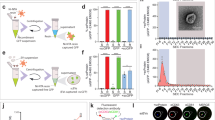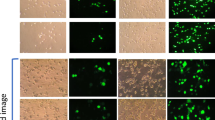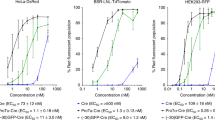Abstract
Promising advances in nonviral gene transfer have been made as a result of the production of cationic liposomes formulated with synthetic cationic lipids (cytofectins) that are able to transfect cells. However few cationic liposome systems have been examined for their ability to transfect CNS cells. Building upon our earlier use of cationic liposomes formulated from 3β-[N-(N′,N′-dimethylaminoethane)carbamoyl] cholesterol (DC-Chol) and dioleoyl-L-α-phosphatidyl-ethanolamine (DOPE), we describe studies using two cationic viral peptides, μ (mu) and Vp1, as potential enhancers for cationic liposome-mediated transfection. Mu is derived from the condensed core of the adenovirus and was selected to be a powerful nucleic acid charge neutralising and condensing agent. Vp1 derives from the polyomavirus and harbours a classical nuclear localisation signal (NLS). Vp1 proved disappointing but lipopolyplex mixtures formulated from pCMVβ plasmid, mu peptide and DC-Chol/DOPE cationic liposomes were able to transfect an undifferentiated neuronal ND7 cell line with β-galactosidase reporter gene five-fold more effectively than lipoplex mixtures prepared from pCMVβ plasmid and DC-Chol/DOPE cationic liposomes. Mu was found to give an identical enhancement to cationic liposome-mediated transfection of ND7 cells as poly-L-lysine (pLL) or protamine sulfate (PA). The enhancing effects of mu were found to be even greater (six- to 10-fold) when differentiated ND7 cells were transfected with mu-containing lipopolyplex mixtures. Differentiated ND7 cells represent a simple ex vivo-like post-mitotic CNS cell system. Successful transfection of these cells bodes well for transfection of primary neurons and CNS cells in vivo. These findings have implications for experimental and therapeutic uses of cationic liposome-mediated delivery of nucleic acids to CNS cells.
This is a preview of subscription content, access via your institution
Access options
Subscribe to this journal
Receive 12 print issues and online access
$259.00 per year
only $21.58 per issue
Buy this article
- Purchase on Springer Link
- Instant access to full article PDF
Prices may be subject to local taxes which are calculated during checkout





Similar content being viewed by others
References
Wood MJA et al. Inflammatory effects of gene-transfer into the CNS with defective HSV-1 vectors Gene Therapy 1994 1: 283–291
Byrnes AP et al. Adenovirus gene-transfer causes inflammation in the brain Neuroscience 1995 66: 1015–1024
Naldini L et al. In vivo gene delivery and stable transduction of nondividing cells by a lentiviral vector Science 1996 272: 263–267
Miller AD . Cationic liposomes for gene delivery Angewandte Chemie-International Edition 1998 37: 1769–1785
Lee RJ, Huang L . Lipidic vector systems for gene transfer Crit Rev Ther Drug Carr Syst 1997 14: 173–206
Gao X, Huang L . Cationic liposome-mediated gene-transfer Gene Therapy 1995 2: 710–722
Felgner PL et al. Lipofection – a highly efficient, lipid-mediated DNA-transfection procedure Proc Natl Acad Sci USA 1987 84: 7413–7417
Farhood H, Serbina N, Huang L . The role of dioleoyl phosphatidylethanolamine in cationic liposome mediated gene transfer Biochim Biophys Acta 1995 1235: 289–295
Caplen NJ et al. In vitro liposome-mediated DNA transfection of epithelial cell lines using the cationic liposome DC-Chol/DOPE Gene Therapy 1995 2: 603–613
Labat-Moleur F et al. An electron microscopy study into the mechanism of gene transfer with lipopolyamines Gene Therapy 1996 3: 1010–1017
Zabner J et al. Cellular and molecular barriers to gene transfer by a cationic lipid J Biol Chem 1995 270: 18997–19007
Felgner JH et al. Enhanced gene delivery and mechanism studies with a novel series of cationic lipid formulations J Biol Chem 1994 269: 2550–2561
Sahenk Z et al. Gene delivery to spinal motor neurons Brain Res 1993 606: 126–129
Iwamoto Y et al. Liposome-mediated Bdnf Cdna transfer in intact and injured rat brain Neuroreport 1996 7: 609–612
Roessler BJ, Davidson BL . Direct plasmid-mediated transfection of adult murine brain cells in vivo using cationic liposomes Neurosci Lett 1994 167: 5–10
Zhou X, Huang L . DNA transfection mediated by cationic liposomes containing lipopolylysine: characterization and mechanism of action Biochim Biophys Acta 1994 1189: 195–203
Sorgi FL, Bhattacharya S, Huang L . Protamine sulfate enhances lipid-mediated gene transfer Gene Therapy 1997 4: 961–968
Li S, Huang L . Protamine sulfate provides enhanced and reproducible intravenous gene transfer by cationic liposome/DNA complex J Liposome Res 1997 7: 207–219
Vitiello L et al. Condensation of plasmid DNA with polylysine improves liposome-mediated gene transfer into established and primary muscle cells Gene Therapy 1996 3: 396–404
Namiki Y, Takahashi T, Ohno T . Gene transduction for disseminated intraperitoneal tumor using cationic liposomes containing non-histone chromatin proteins: cationic liposomal gene therapy of carcinomatosa Gene Therapy 1998 5: 240–246
Gao X, Huang L . Potentiation of cationic liposome-mediated gene delivery by polycations Biochemistry 1996 35: 9286–9286
Fritz JD et al. Gene transfer into mammalian cells using histone-condensed plasmid DNA Hum Gene Ther 1996 7: 1395–1404
Hagstrom JE et al. Complexes of non-cationic liposomes and histone H1 mediate efficient transfection of DNA without encapsulation Biochim Biophys Acta 1996 1284: 47–55
Isaka Y et al. The HVJ liposome method Exp Nephrol 1998 6: 144–147
Gillock ET et al. Polyomavirus major capsid protein VP1 is capable of packaging cellular DNA when expressed in the baculovirus system J Virol 1997 71: 2857–2865
Chang D, Cai X, Consigli RA . Characterization of the DNA binding properties of polyomavirus capsid proteins J Virol 1993 67: 6327–6331
Anderson CW, Young ME, Flint SJ . Characterization of the adenovirus 2 virion protein, mu Virology 1989 172: 506–512
Hosokawa K, Sung MT . Isolation and characterization of an extremely basic protein from adenovirus type 5 J Virol 1976 17: 924–934
McQuillin A et al. Optimization of liposome mediated transfection of a neuronal cell line Neuroreport 1997 8: 1481–1484
Wood JN et al. Novel cell-lines display properties of nociceptive sensory neurons Proc Roy Soc Lond Ser B Biol Sci 1990 241: 187–194
Caplen NJ et al. Liposome-mediated Cftr gene-transfer to the nasal epithelium of patients with cystic-fibrosis Nature Med 1995 1: 39–46
Nabel G, Chang A, Nabel E . Clinical protocol: immunotherapy of malignancy by in vivo gene transfer into tumors Hum Gene Ther 1992 3: 399–410
Nabel GJ et al. Direct gene-transfer with DNA liposome complexes in melanoma – expession, biological activity, and lack of toxicity in humans Proc Natl Acad Sci USA 1993 90: 11307–11311
Stewart MJ et al. Gene-transfer in vivo with DNA liposome complexes – safety and acute toxicity in mice Hum Gene Ther 1992 3: 267–275
Cooper RG et al. Polyamine analogues of 3 β-[N-(N′,N′-dimethylaminoethane)carbomoyl]cholesterol (DC-Chol) as agents for gene delivery Chemistry 1998 4: 137–151
Thierry AR et al. Characterization of liposome-mediated gene delivery: expression, stability and pharmacokinetics of plasmid DNA Gene Therapy 1997 4: 226–237
Coonrod A, Li FQ, Horwitz M . On the mechanism of DNA transfection: efficient gene transfer without viruses Gene Therapy 1997 4: 1313–1321
Sebestyen MG et al. DNA vector chemistry: the covalent attachment of signal peptides to plasmid DNA Nat Biotechnol 1998 16: 80–85
Hagstrom JE et al. Nuclear import of DNA in digitonin-permeabilized cells J Cell Sci 1997 110: 2323–2331
Budhrammahadeo V, Lillycrop KA, Latchman DS . The levels of the antagonistic Pou family transcription factors Brn-3a and Brn-3b in neuronal cells are regulated in opposite directions by serum growth factors Neurosci Lett 1995 185: 48–51
Acknowledgements
This work was supported by a grant from the Motor Neurone Disease Association. SIS thanks the BBSRC and Genzyme for a CASE studentship. We thank the Mitsubishi-Tokyo Pharmaceutical company for supporting the Imperial College Genetic Therapies Centre and the West Riding Medical Research Trust for their support.
Author information
Authors and Affiliations
Rights and permissions
About this article
Cite this article
Murray, K., Etheridge, C., Shah, S. et al. Enhanced cationic liposome-mediated transfection using the DNA-binding peptide μ (mu) from the adenovirus core. Gene Ther 8, 453–460 (2001). https://doi.org/10.1038/sj.gt.3301401
Received:
Accepted:
Published:
Issue Date:
DOI: https://doi.org/10.1038/sj.gt.3301401
Keywords
This article is cited by
-
Structure prediction and validation of an affibody engineered for cell-specific nucleic acid targeting
Systems and Synthetic Biology (2010)
-
Cell Biological and Biophysical Aspects of Lipid-mediated Gene Delivery
Bioscience Reports (2006)
-
Medicinal chemistry of plasmid DNA with peptide nucleic acids: A new strategy for gene therapy
International Journal of Peptide Research and Therapeutics (2003)
-
Characterisation of LMD virus-like nanoparticles self-assembled from cationic liposomes, adenovirus core peptide μ (mu) and plasmid DNA
Gene Therapy (2002)



